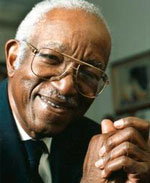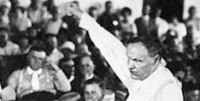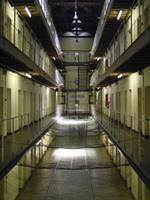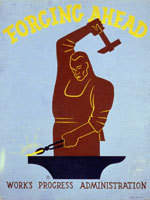Making Voting Rights a Reality in Mississippi
Graduate student Rachel Reinhard explores the African American struggle to realize voting rights in Mississippi during and following the Civil Rights Movement.
Graduate student Rachel Reinhard explores the African American struggle to realize voting rights in Mississippi during and following the Civil Rights Movement.
In this Library of Congress presentation, the children of author and civil rights activist M. Carl Holman—Kinshasha Holman-Conwill, Kwasi Holman, and Kwame Holman—reflect on the character of their father, who also served as the director of the National Urban Coalition.

John Hope Franklin, African American historian, professor, and civil rights activist, passed away on March 25. His life work changed the way we explore, analyze, construct, and teach American history. "He not only studied history; he made it," explains an editorial in The Washington Post.
Franklin lived and acted with a conviction that historians have a voice and an obligation to the present and to the determination of public policy. "Using one's skills to influence public policy seemed to be a satisfactory middle ground between an ivory tower posture of isolation and disengagement and a posture of passionate advocacy that too often deserted the canons of scholarship," he said.
As an historian, he is credited as the first to contextualize African Americans in the historiography of American history with the 1947 publication of From Slavery to Freedom: A History of African Americans, a book he continuously revised and whose sales have exceeded 3 million copies throughout the world. As his obituary from Duke University states, "At the time From Slavery to Freedom was published, there were few scholars working in African-American history and the books that had been published were not highly regarded by academics. To write it, he first had to give himself a course in African-American history, then spend months struggling to complete the research in segregated libraries and archives—including Duke's, where he could not use the bathroom."
He published his last book, Mirror to America: The Autobiography of John Hope Franklin, in 2005.
In the almost-60 intervening years, John Hope Franklin wrote history, taught history, and made history. The articles and multimedia links below highlight his life and hint at the depth of his influence.
News from the American Historical Association includes links to Franklin's work and online interviews.
Duke University Remembers John Hope Franklin is a website dedicated to accomplishments, quotes, statements, and images. The site (including the detailed obituary cited earlier) offers the opportunity to share condolences and memories. The Gallery includes filmed interviews with Franklin, courtesy of University of North Carolina TV.
Franklin was the James B. Duke Professor Emeritus of History at Duke University where he founded the John Hope Franklin Center for Interdisciplinary and International Studies and whose Rare Book, Manuscript, and Special Collections Library houses the John Hope Franklin Collection of African and African American Documentation.
The John Hope Franklin Humanities Institute, a part of the Center for Interdisciplinary and International Studies, has also posted biographical interviews with Franklin on his work as a historian, including Dr. Franklin on the Role of the Historian in the World.
Franklin is memorialized in a comprehensive biography in The New York Times.
He spoke with journalist Gwen Ifill about his autobiography and the state of race in America in 2005 during a PBS interview.
Under Historians in the News, the History News Network encourages readers to post their memories of John Hope Franklin, links to news articles and videos, and offers articles from the HNN archives by and about Franklin.
Distinguished historian and lifelong civil rights activist Professor John Hope Franklin joins archivist Allen Weinstein and Dr. Lonnie Bunch, director of the new National Museum of African-American History and Culture, to discuss his careers as educator, scholar, and activist.
To watch this interview, scroll to "John Hope Franklin," and select "Watch the Video."
Congressman Conyers leads a discussion of the legislative history of efforts to establish a federal holiday in honor of Dr. Martin Luther King Jr. and the continuing significance of the Reverend Dr. King's life. The Congressional Black Caucus and its co-founder Rep. Conyers were leaders in that effort. After their presentations, the panelists responds to audience members' questions.
In November 1983, President Ronald Reagan signed into law legislation declaring the third Monday in January as the Martin Luther King, Jr. Federal Holiday, to celebrate the birthday and life of the slain civil rights leader. It had been 15 years since Dr. King's assassination.
This video shows a student thinking-aloud while reading a headnote to an excerpt from Bayard Rustin's diary. In this 58-second reading, the student puzzles through the motives of civil rights leaders, who were concerned that Rustin—a gay Communist—would undermine the movement. He identifies the importance of context in his reading, noting that "this was during a great fear of Communists in America" and that if the movement was aligned with Communists, "it would lose a lot of support." The accompanying written commentary highlights the importance of contextualization, which the student uses to better understand a world in which civil rights activists would exclude someone who was different. Find the document the student reads here.

Four guided investigations designed to teach students how to read primary sources and construct historical narratives lie at the heart of this website. Topics are: the Spanish-American War, the Scopes Trial, Social Security, and Rosa Parks. Each topic includes a short introductory video, a timeline of events, a central question, and extension activities. For example, the Rosa Parks investigation poses the question: "Why did the boycott of Montgomery's buses succeed?"
After completing a simple login, students read annotated documents—including letters written by the boycott organizers, a speech by Martin Luther King, Jr. and an interview with a woman working in Montgomery—and answer guiding questions, and draw on their responses to answer the question. The website also includes a useful introduction to the idea of historical thinking.

Especially since the 1950s, civil rights litigation has done much to influence government institutions. This website presents at least partial information on 2,243 injunctive civil rights cases (those seeking policy change and not money). These cases are divided by category. "Jail Conditions" and "Prison Conditions" contain the most cases, with roughly 550 each. "Immigration" and "Juvenile Institutions" also include more than 150 each. Other categories include: "Mental Health Institutions," "Mental Retardation Institutions," "Child Welfare," "Nursing Home Cases," "Policing Cases," "Public Housing," "Equal Employment," and "School Desegregation," among others.
A good place to begin is the "Featured Cases" section on the website's homepage, which highlights cases from the collection that are being litigated currently and/or that are particularly relevant to current events. Cases are fully searchable by name, type, issue, district, circuit, state, causes of action, attorney organization, and people involved in the case. In addition, links to 141 case studies written by law students, professors, journalists, and policy advocates provide in-depth information on a specific case or issue, such as the Urban Institute's "Baseline Assessment of Public Housing Desegregation Cases." New material is added regularly.
According to the Library of Congress Webcasts summary, in this video, "Joseph Kip Kosek, assistant professor at George Washington University, discussed the impact of radical Christian pacifists on American democratic theory and practice, at the Library of Congress. Kosek, the author of Acts of Conscience: Christian Nonviolence and Modern American Democracy and a former fellow of the Library's John W. Kluge Center, talked about his book. According to Kosek, in response to the massive bloodshed that defined the 20th century, American religious radicals developed an effective new form of nonviolent protest, one that combined Christian principles with new uses of mass media. Greatly influenced by the ideas of Mohandas K. Gandhi, these 'acts of conscience' included sit-ins, boycotts, labor strikes and conscientious objection to war. Beginning with World War I and ending with the ascendance of Martin Luther King Jr., Kosek traces the impact of radical Christian pacifists on America."

In "A Sociocultural Perspective on Children’s Understanding of Historical Change: Comparative Findings From Northern Ireland and the United States," Keith Barton, a professor at Indiana University, looked at how children in different countries learn history, specifically the role played by narrative.
Barton observed that American students learn the "story" of American history, more often than not, as one of perpetual progress. In Northern Ireland, history is seen as relationships among social institutions over time, not a story about progress.
Barton wondered about the effects of such an approach. To that end he interviewed 121 students, ages 6–12, in four schools across Northern Ireland, asking how and why life had changed over time. Along with classroom observations and collecting data from history-related settings like museums, Barton’s interviews demonstrated how students in a non-American cultural context learn about history.
When he compared these to studies done in the United States, Barton found that American students portray historical change as straightforward, linear, and generally beneficial progress, while the Irish students saw history as either random and ambiguous, or cyclical. The American students studied tended to focus on accomplishments of historical figures, whereas students in Northern Ireland often discussed the role of societal and economic forces.
The "story" of history taught to American students frequently takes the form of a "quest-for-freedom" narrative in which life slowly but surely gets better for all Americans. This serves to unite a diverse society, such as is found in the U.S. By contrast, in Northern Ireland, where Protestants and Catholics remain divided, the narrative form creates the potential for opposing sides to take aim at each other. Consequently, in Northern Ireland, the primary emphasis in history is on societal relationships—relationships between different groups, as well as between people and institutions.
History classes in the United States also tend to focus more on the role of exceptional individuals in driving history forward. In this version of history prominent figures initiate a series of events which follow a causal chain to bring about significant change. For example, the American students learned that the civil rights movement was the product of Martin Luther King, Jr.’s genius rather than a broad range of social and institutional forces. In Northern Ireland, the students focused less on individuals and more on issues relating to social and economic structures. Barton suggests this may be because Americans are more comfortable dealing with individuals and their stories than with issues such as social class and prejudice. Conversely, there are few historical figures taught in Northern Ireland classrooms who don't represent a political position of one kind or another. Thus, while the Northern Irish are comfortable discussing social class, for instance, they have less experience examining the influence of particular individuals.
Barton's study showed that narratives about American history are frequently positive stories about the triumph of progress: as time passes, technology improves, freedoms expand, and life gets better. In Northern Ireland, stories about progress are much less common. Time goes on and life changes, but they do so in unpredictable ways. Barton argues that while a focus on progress may be positive, giving students a feeling of shared identity and inspiring their belief that Americans can learn from their mistakes, relying solely on such a narrative doesn't acquaint students with the effects of societal forces on individual actions or the diversity that exists at any given time in history.

Help students understand that the passage of time doesn't always bring what is commonly viewed as "progress."
In interviewing students in Northern Ireland, Barton gave them a number of exercises. One asked the students to explain why British students were once caned—hit with a reed or branch—by their teachers, and why the practice ceased. In answering, one third of the students attributed the change to inevitable progress:
Because over time they realized that they should be less strict.
They just found out that it’s really, really bad, and they’re thinking of other people’s feelings now.
In explaining how things change, these students didn't mention collective action or how institutional change can bring about social improvements. However, the rest of the students—two-thirds of those interviewed by Barton—pointed to changing social relations, collective action like strikes and protests, and evolving legal and government institutions:
Because if you cane them, you could get sent to jail. . . it’s against the law to hurt somebody that you don’t know.
New people came in. . . and they made new rules like child abuse, like jails, and all that kind of thing.
For these students, caning ended not because of inevitable progress, or even due to a change in attitude; instead, the changing attitudes themselves led to collective action, that in turn produced new laws and regulations.
Keith Barton, "A Sociocultural Perspective on Children’s Understanding of Historical Change: Comparative Findings From Northern Ireland and the United States," American Educational Research Journal 38, no. 4 (Winter 2001), 881-913.